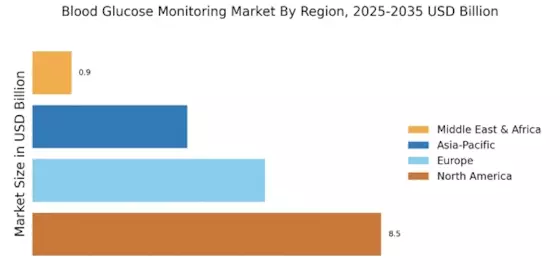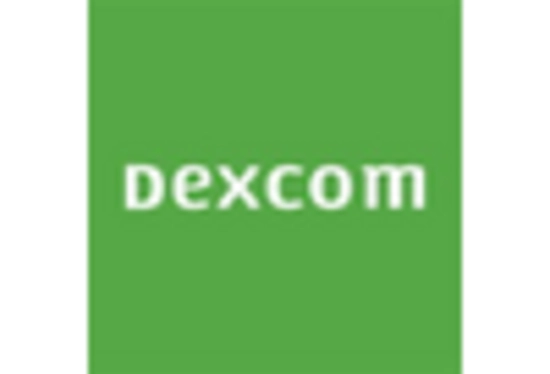The Blood Glucose Monitoring Market is characterized by a dynamic competitive landscape, driven by technological advancements and an increasing prevalence of diabetes globally. Key players such as Abbott (US), Roche (CH), and Dexcom (US) are at the forefront, each adopting distinct strategies to enhance their market positioning. Abbott (US) focuses on innovation, particularly with its FreeStyle Libre system, which has revolutionized continuous glucose monitoring (CGM) through its user-friendly design and real-time data capabilities. Roche (CH), on the other hand, emphasizes partnerships and collaborations, aiming to integrate its Accu-Chek products with digital health platforms to provide comprehensive diabetes management solutions. Dexcom (US) is heavily invested in digital transformation, leveraging data analytics to improve patient outcomes and streamline healthcare provider interactions. Collectively, these strategies contribute to a competitive environment that is increasingly centered around technological innovation and patient-centric solutions.
In terms of business tactics, companies are localizing manufacturing and optimizing supply chains to enhance efficiency and reduce costs. The Blood Glucose Monitoring Market appears moderately fragmented, with several players vying for market share. However, the influence of major companies is substantial, as they set industry standards and drive innovation. This competitive structure allows for a diverse range of products and services, catering to various consumer needs while fostering an environment ripe for collaboration and strategic partnerships.
In August 2025, Abbott (US) announced the launch of its next-generation FreeStyle Libre 3 system, which boasts improved accuracy and a smaller sensor size. This strategic move is likely to reinforce Abbott's leadership in the CGM segment, as it addresses consumer demand for more discreet and efficient monitoring solutions. The introduction of this product not only enhances patient experience but also positions Abbott to capture a larger share of the growing market for continuous glucose monitoring.
In September 2025, Roche (CH) entered a strategic partnership with a leading telehealth provider to integrate its Accu-Chek devices with remote monitoring capabilities. This collaboration is indicative of Roche's commitment to digital health solutions, allowing for real-time data sharing between patients and healthcare providers. Such integration is expected to improve patient adherence to treatment plans and enhance overall diabetes management, thereby solidifying Roche's competitive edge in the market.
In October 2025, Dexcom (US) unveiled its latest software update, which incorporates artificial intelligence to provide personalized insights for users. This advancement reflects Dexcom's focus on leveraging technology to enhance user engagement and improve health outcomes. By integrating AI into its monitoring systems, Dexcom not only differentiates itself from competitors but also aligns with the broader trend of digitalization in healthcare, which is increasingly becoming a critical factor in patient care.
As of October 2025, the Blood Glucose Monitoring Market is witnessing trends that emphasize digitalization, sustainability, and the integration of artificial intelligence. Strategic alliances are becoming more prevalent, as companies recognize the value of collaboration in enhancing product offerings and expanding market reach. Looking ahead, competitive differentiation is likely to evolve, shifting from traditional price-based competition to a focus on innovation, technological advancements, and supply chain reliability. This transition underscores the importance of adaptability and forward-thinking strategies in maintaining a competitive advantage in an ever-evolving market.


















Leave a Comment